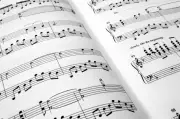Making sure it’s public domain sheet music

If you’re a choir or chorus director, can you photocopy an arrangement of public domain sheet music or must you purchase multiple copies of the music? What if you’ve found a new, beautifully typeset edition that includes minor corrections? It has a copyright notice on it, right? But is it really protected by copyright? How can you tell?
If knowing more about public domain sheet music — what you can do with it and some things to be careful of when using it — would help you, you’ve landed on the right page.
Before we get started — if you’re just looking for places to find public domain sheet music, see the free sheet music page. Okay now ...
If it’s public domain sheet music, here’s what you can do
When sheet music is in the public domain, you can freely:
- record it
- remix it
- copy and distribute it
- perform it in public
Many artists have been inspired by those who have come before them and have used public domain music to create new works. For example, see this Wikipedia list of popular songs based on classical music.
If it’s not public domain sheet music, watch out
When sheet music is not in the public domain you must deal with things like these (depending on how you want to use the work):
- performance royalties
These are the fees you must pay the copyright owner for permission to perform copyrighted sheet music in public (except at religious services or nonprofit functions). The copyright owner is usually the music publisher.
Performing rights societies collect performance royalties through license agreements. In the US, there are three performing rights societies: ASCAP, BMI, and SESAC. How much of a fee you must pay depends on your use.
- mechanical royalties
These are the recording fees you must pay to record copyrighted sheet music. In the US, the Harry Fox Agency collects these royalties. Mechanical royalties currently range from 9.10 cents per copy for songs of 5 minutes or less, or 1.75 cents per minute of playing time for songs over 5 minutes.
- synchronization licenses
If you want to use a copyrighted musical composition in connection with an audiovisual work (including works on the Internet), you’ll need a synchronization license. Synchronization licenses apply anywhere you’re reproducing music in connection (usually in timed relation) with visual images.
The Harry Fox Agency used to handle synchronization licenses. They don’t anymore. Now you must contact the copyright owner directly. As I mentioned above, that’s usually the music publisher.
- master recording license
A synchronization license grants you the authority to reproduce a musical composition only. If you wanted to reproduce a specific recording of a composition, you would need to get a master recording license. Master recording rights are held by whoever controls the recorded version of a song — usually a record label.
- reproduction rights
You would also need the copyright owner’s permission to reproduce sheet music. Yet another reason to be sure whether the original sheet music you’re using is in the public domain or not.
- adaptation rights
If you wanted to remix the music — that is, adapt the melody or the lyrics for use in a new composition of your own — you’d need the copyright owner’s permission.
As you can imagine, a music licensing scenario can get pretty hairy, depending on what you want to do with the copyrighted music. You might need a synchronization license and a master recording license, or maybe just a synchronization license. Or maybe just a mechanical license. Confusing? You bet, to say nothing of expensive. But here’s the good news ...
With public domain sheet music you don’t have to worry about any of this. If the music is in the public domain, you can perform it publicly — wherever you like, without paying any fees at all. You can make copies of it, record it, remix it, use it in a film or on a web site ... it’s up to you.
You do have to establish that the sheet music really is public domain, though. And you should know about a few things that might trip you up — more on that in a minute.
How do you know it’s public domain sheet music?
Here are the main ways sheet music can enter the public domain:
- the music’s copyright has expired;
- the music was published before 1989 without a valid copyright notice; or
- the music was first published from 1923 through 1963 and the copyright wasn’t renewed on time.
To learn how to tell if a work is in the public domain for these reasons, and more, take the tutorial on copyright and the public domain.
Note: To know if a work’s copyright has expired you must know whether the work has been published. Performing a piece of music does not publish the music, by the way. And before January 1, 1978, music was considered published only when sheet music was distributed to the public. If the music was distributed on recordings only (vinyl records, 8-track tapes, whatever), it was not considered published.
Okay, back to the task at hand. (But do take the tutorial if you’re at all confused. The page on copyright expiration has more info on publication.)
Now what’s that about potential problems?
If sheet music is in the public domain it’s copyright free music, right? Right. But what if the sheet music you want to use is a new edition or an arrangement of a public domain piece? What then?
Let’s find out ...
Part 2: Avoiding Problems with Public Domain Music »
